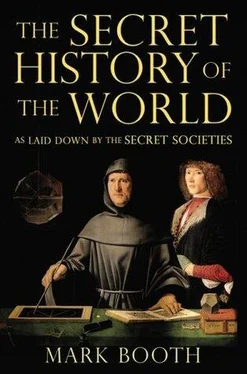Proclus says that three hundred years after Solon, Crantor was shown columns by the priest of Sais covered with a history of Atlantis in hieroglyphic characters. A near-contemporary of Plato’s, now known as pseudo-Aristotle, wrote about a similar island paradise in his book On Marvellous Things Heard .
The Greek historian Marcellus, also a near contemporary of Plato’s, is clearly relying on ancient sources when he writes that ‘in the Outer Ocean [the Atlantic] there are seven small islands and three larger ones, one of which was dedicated to Poseidon’. This ties in with Plato’s account in terms of the number of kingdoms. A Greek historian of the fourth century BC, Theopompus of Chios, retells a story told two hundred years before Plato by Midas of Phrygia, that ‘besides the well-known portions of the world — Europe, Asia, Libya (Africa) — there is another which is unknown, of incredible immensity where vast blooming meadows and pastures feed herds of various huge and mighty beasts and where the men are twice the height and live to twice the age of men’. As we have already seen, Enoch and the myths and legends of many cultures around the world recorded the prevalence of giants before the Great Flood.
Then, of course, there is the Greek myth of the Great Flood. The story of Deucalion is much older than Plato. As in both Plato’s account and the biblical one there is an implication here that the Great Flood was intended to destroy the greater part of humankind, because the development of humankind had gone wrong. Rudolf Steiner has pointed out that the stories of the demi-gods and heroes, Cadmus, Theseus, Jason — all involve journeys eastwards. We should read them, he says, as stories of migrations which took place as conditions on the Atlantean islands deteriorated and before the final catastrophe.
When Plato writes about Poseidon, the first god-king of Atlantis, this should remind us of what we saw in Chapter 5 — that Poseidon was the original half-fish form of Zeus/Jupiter. Poseidon was also god of the raging sea, god of subterranean, volcanic depths, whose bull-bellowing roar signalled climatic catastrophe. Poseidon was at work at both the beginning and end of Atlantis’s history.
Other ancient cultures cross-reference Plato’s account. The South American Aztecs recorded that they came from ‘Aztlan’, ‘the land in the middle of the water’. Sometimes this land was called ‘Aztlan of the Seven Caves’. It was depicted as a central, large step pyramid surrounded by six smaller pyramids. According to traditions collected by the invading Spaniards, humanity had nearly been wiped out by a vast flood, and would have been but for a priest and his wife who constructed a boat made out of a hollow log, in which they also rescued seeds and animals. The complex and sophisticated astronomy of these South American tribes has allowed one modern researcher to deduce that they dated this flood to about 11,600 BC.
This might seem a long way from Plato’s date of around 9600 BC, but the crucial point here is that both dates agree in setting the Flood at the end of the Ice Age. Modern geology tells us that as the ice caps melted, a series of floods swept down from the north. We have already noted the suggestion that the islands of Atlantis suffered several catastrophic floods over a long period before the last island was finally, completely, submerged.
Underwater archaeologists are today discovering in many parts of the world the remains of civilizations which were covered by floods caused by the melting of ice at the end of the Ice Age. In April 2002 divers stories told by local fishermen were used to help locate the lost city of the Seven Pagodas off the coast of Mahabalipuram in India. The temple-like structures that have been found are much grander and more complex than we would expect for the end of the Ice Age — the Neolithic, or New Stone Age. Author and investigator Graham Hancock, who has done so much to question our academic assumptions about ancient history, was quoted at the time as saying, ‘I have argued for many years that the world’s flood myths deserve to be taken seriously, a view that most Western academics reject. But here in Mahabalipuram, we have proved the myths right and the academics wrong.’
I myself have seen artefacts retrieved from the sea bed off the American Atlantic coast — the so-called Scott stones — which I am persuaded it would very difficult for technology to reproduce today, let alone eleven thousand years ago when the area in question went under the sea. In design terms the Scott stones show features which are remarkably similar to Egyptian artefacts. This is not my secret to reveal, but I hope that perhaps by the time this book is published Aaron du Val, President of the Miami Museum Egyptological Society, may have chosen to show the world what he has.
No detailed description of the events that put such artefacts under the sea has survived in the Greek myths that have come down to us, and the biblical account is characteristically brief, but these can be supplemented and illumined by accounts from other cultures, particularly the Sumerian and other Near Eastern accounts. No scholars dispute that some of these accounts from older cultures provided source material for the biblical story. Elements familiar to us from the biblical account, such as the ark, the doves and the olive branch, appeared in the earlier Sumerian account, where Noah is called Ziusudra. He appears, too, in the Mesopotamian account where he is called Atrahasis and in the Babylonian account which names him Upnapishtim. Weaving these different versions together creates an amplified version of the biblical story:
One day Noah was standing in a reed hut, when he heard a voice coming through the wall that warned him of a rainstorm that would wipe out mankind. Tear down your reed hut and build a boat, he was told. Noah and his family set about building a great vessel made out of reeds, finally daubing it with bitumen in order to make it watertight. Everything growing out of the ground, everything grazing on it, the birds of the sky, the cattle and the wild animals roaming open country, he put in. Then for six days and nights the storm blew and their boat was tossed about by the waves. The downpour, the storm and the flood overwhelmed the surface of the earth. On the seventh day, hearing the winds begin to fall, Noah opened a window and light fell on his face. The world was silent, because all humanity had been returned to clay…
The catastrophic deluge that nearly destroyed humankind is remembered every year by both the living and the dead on the Day of the Dead or Halloween. In England as late as the nineteenth century villagers would dress up as the dead, wear masks and make a mum-mumming sound with closed lips to imitate the sound made by the walking dead — hence the word ‘mummers’.

WHEN NOAH AND HIS FAMILY DISEMBARKED to set foot on dry land, something rather odd happened. ‘And Noah began to be a husbandman and he planted a vineyard, and he drank of the wine, and was drunken, and he was uncovered within his tent. And Ham saw the nakedness of father and told his two brethren without.’ (Genesis 9.20-22)
It is entirely fitting that Noah should become a husbandman, because archaeology tells us that agriculture began during this period, the Neolithic. But what are we to make of the strange story of his drunken nakedness?
In order to make sense of it, we must turn to the tradition that identifies Noah with the legendary Greek figure Dionysus the Younger.
We need to disentangle two different strands of stories concerning two figures with the same name. Dionysus is the name of two distinct individuals, a god and later a demi-god. These two make very different contributions to human history in two different eras. The Dionysus who should be identified with Noah is very different from the earlier Dionysus Zagreus, the Elder Dionysus, the story of whose dismemberment we told in Chapter 6.
Читать дальше













